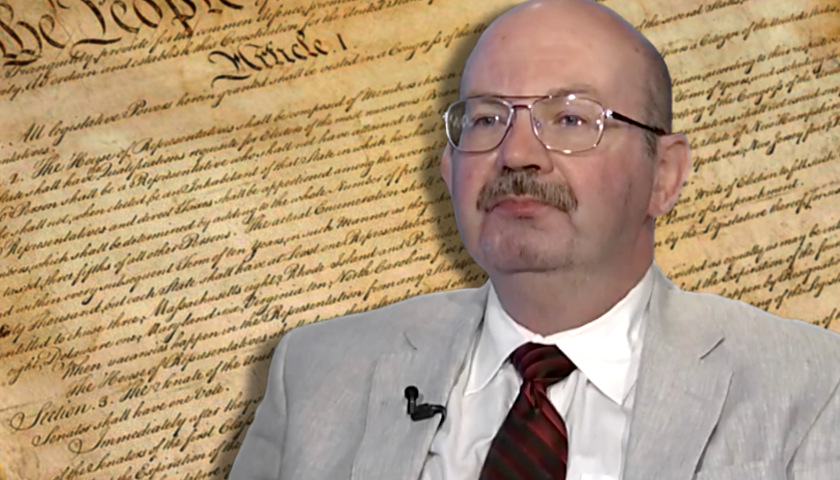Gregory Watson has been recognized by historians, academics, and elected officials as the only individual in American history whose singular efforts are responsible for the ratification of an amendment to the United States Constitution.
Mr. Watson has provided this first hand account of his successful efforts to persuade state legislatures across the country to ratify the 27th amendment exclusively to The Tennessee Star.
For me, the journey of amending the United States Constitution in 1992 really started some 14 years earlier in 1978. During that summer, my family moved over 1,000 miles from Michigan to Texas. I was age 16 at the time and I still had the final two years of high school ahead of me to complete.
While sharing a border with Dallas, the suburb of Mesquite, Texas, was not connected with Dallas’ public transit service. Although of legal age to obtain a driver’s license, since I did not have access to a vehicle, I was unable to travel from Point A to Point B and had to seek other ways to achieve intellectual stimulation during those two years of residency in Mesquite. After graduating from Mesquite High School in May of 1980, I relocated to Austin during August of that year to begin attendance at the main campus of the University of Texas.
In Mesquite, when I would arrive home after school each weekday afternoon during 1978, 1979 and 1980, it was routine for me listen to television news and to stay very attuned to public events locally, statewide and nationally. My muse was in constant search of sustenance.
August of 1978 was literally the last time that Congress proposed an amendment to the United States Constitution, as outlined in Article V. Had that 1978 measure been ratified by the legislatures of 38—or more—states by its 1985 deadline, it would have granted to Washington, D.C., two United States Senators and however many members of the U.S. House of Representatives the District of Columbia’s population would have warranted.
By October of 1978, Congress had taken yet another bold action with significant relevance to amending the Federal Constitution. Both the U.S. House of Representatives and the U.S. Senate voted to purportedly extend the previously agreed-upon deadline for the state legislatures to act upon the 1972 Equal Rights Amendment (ERA) which had stalled rather badly. The most recent state legislature to ratify ERA was the Indiana General Assembly in 1977—the only state to do so since 1975. The original ERA ratification deadline was March 22, 1979 and the 95th Congress supposedly revised that by more than three years to June 30, 1982.
Back in 1972, some Americans simply assumed that the ERA would end up in the Constitution as its 27th Amendment. A number of contemporary documents even presumptuously referred to ERA as the 27th Amendment. But history turned out differently. By 1978, lawmakers in 35 of the necessary 38 states (three-fourths of the 50) had ratified ERA, and four (Idaho, Kentucky, Nebraska and Tennessee) of those 35—upon deeper reflection—chose to rescind their prior ERA approvals, perhaps bringing the total down to just 31 ratifications.
Hence, the seeds had been planted in my brain. From autumn 1978 forward, I frequently pondered the procedure by which the Federal Constitution is amended. I debated quietly to myself whether it is appropriate for a state legislature to have power to rescind a previously-given ratification. I further silently wrestled with the question of whether it is proper for Congress to “extend” a previously-agreed upon ratification deadline. With these spirited debates, I was able, as early on as 1978, to busy myself thinking lofty thoughts about how the U.S. Constitution is amended.
Fast forwarding to March of 1982, I was enrolled in a course, Government 310L, at the University of Texas at Austin. It was just before Spring Break, and students in the class were instructed to write a paper about a governmental process. Questions were still dancing in my mind in 1982 about the Equal Rights Amendment and whether it was actually still alive after the original deadline of March 22, 1979.
For example, the South Dakota Legislature adopted a resolution, 21 days ahead of the original deadline, proclaiming that their 1973 ERA ratification would only be valid through March 22, 1979—and not a day more.
In December of 1981, a federal district court ruled in the case of Idaho v. Freeman that the ratification deadline for ERA was, in fact, March 22, 1979, and that Congress was without authority to extend it beyond March 22, 1979. In January of 1982, the U.S. Supreme Court, however, “stayed” the lower court’s ruling, thus allowing state lawmakers during early 1982 to keep considering the ERA.
Likewise still unclear was whether rescission by state lawmakers of a prior ratification was allowable. So, I initially set out to write my March 1982 paper about the controversies that continued to swirl around the ERA in early 1982.
Also, in January of 1982, I had been hired to work for a member of the Texas House of Representatives at the Texas State Capitol, situated only a few blocks south of the University campus. My employment in the Texas Legislature gave me access to helpful reference materials that I otherwise probably would never have even known about, which well-supplemented what was available to me at the UT-Austin libraries.
For my March 1982 paper, I had begun some preliminary research into the arguments that ERA deadline extension advocates had used in 1977 and 1978 to persuade the 95th Congress to grant the ERA additional time before America’s state legislators. And the December 1981 case of Idaho v. Freeman was, of course, very much in my thoughts, too. From that initial probing, I learned about a very important 1939 U.S. Supreme Court decision in the case of Coleman v. Miller. I also learned that the first time that Congress ever placed a ratification deadline on a proposed constitutional amendment was in the year 1917. Thus, any amendment offered to the states before 1917 had no ratification deadline.
To further explore the ERA, I next visited the downtown Austin public library, later named for Austin celebrity John Henry Faulk. There, I stumbled upon a book that had within it a chapter discussing amendments which Congress had proposed to the nation’s state legislatures but which not enough state legislatures had approved in order to be incorporated into the Constitution.
As I stood in the municipal library’s aisle, holding that book in my hands, I was stunned to see an unratified amendment offered to the state legislatures by Congress in the year 1789 which stipulated that any adjustment in the salary of members of Congress would have to await the intervention of a biennial election.
Remembering what had occurred only a few months earlier, in December of 1981, by which members of Congress gave themselves a special tax break—hidden in a non-germane bill to assist the coal miners of Kentucky and West Virginia who were afflicted with “Black Lung Disease”—I immediately sensed the significance of the 1789 unratified proposal. That tax break was exclusively for members of Congress and, in my mind, it was just a back-door pay raise for U.S. Senators and U.S. Representatives.
I felt a surge of electricity as I held that book in my hands. It was as if political lightning had struck me in the City’s central library. Likewise recalling the landmark 1939 Coleman v. Miller decision, I instantly chose to switch the topic of my paper from the procedural disputes surrounding the 1972 ERA to, instead, the unratified 1789 Congressional Compensation Amendment.
In writing the paper, on its now revised focus, my purpose was two-fold.
First, according to the Coleman v. Miller ruling, any amendment which Congress had offered to the nation’s state lawmakers—without a ratification deadline—remains pending business before the state legislatures, regardless of when Congress offered it to the states. Then, should Congress ever be presented with the necessary number of ratifications by the state legislatures, Congress itself would be the final arbiter as to whether too much time had elapsed between Congress’ initial proposal of that constitutional amendment and the most recent state legislature’s ratification of that amendment.
Second, I sought to demonstrate that the 1789 proposal was still needed, as Congress had shown a propensity to use its lawmaking authority to enrich its members financially.
Personal computers being a rarity in 1982, I completed the paper on my IBM Correcting Selectric II typewriter. I put much love into the wording and the typing of that paper—taking care to switch out the typeface “element” (which was shaped like a ball and was easily removable) for italic font and for Olde English font to make the paper not only informative but, indeed, visually pleasing as well.
A few days later, when I got the paper back from the Teaching Assistant, I was very disappointed by the grade of “C” written on the front of it. I tried to negotiate with the TA. He was having none of it. I then decided to appeal the grade up to the Professor. I handed it to her and she told me that she would take a look at it. A few days after that—as I sat in the aisle of the auditorium-sized “classroom”—she physically tossed the paper at me and muttered “No change”.
Right then and there, I decided that I would work to get the 1789 Congressional Compensation Amendment ratified by the requisite number of state legislatures. At the time, I had been under the mistaken impression that the last state to ratify it was Virginia in the year 1791, the sixth to approve it.
Returning to that controversial December 1981 congressional tax break—which the outraged public demanded be swiftly repealed—I tried the strategy of contacting members of Congress who had filed legislation early during the 2nd Session of the 97th Congress to revoke the offending pre-Christmas tax break. I asked if any of them could recommend to me a member of the legislature back in their home state who might be willing to file a resolution at the state capitol to ratify the 1789 Congressional Compensation Amendment.
I did strike some gold. Among those whom I had contacted was then-U.S. Senator William S. Cohen of Maine. Cohen replied that indeed he knew of a member of the Maine Legislature who would be well-suited to file a ratifying resolution in Augusta. Something must have happened to that Maine state lawmaker—perhaps he was not re-elected in November 1982. I was pleased to learn, however, that the task had thoughtfully been passed along to another member of the Maine Legislature. This other gentleman filed the required resolution in the Maine Senate and secured its approval by that chamber. Next, he got it through the Maine House of Representatives. Hence, by April 27, 1983, Maine had formally ratified the 1789 Congressional Compensation Amendment.
I shifted gears in 1984, choosing to target states in which both legislative chambers were Republican-controlled. That year, the Colorado General Assembly fit that description. I sent letters to the majority party leadership of both the Colorado Senate and Colorado House of Representatives. Ultimately, a House member filed the necessary resolution which passed the Colorado House of Representatives and then the Colorado Senate, making the “Centennial State” the next success story as of April 18, 1984.
After 1984, the ratification process greatly accelerated. In 1985, five states ratified the 1789 measure, including Tennessee. In 1986, three more. In 1987, four more. In 1988, three more. In 1989, a whopping seven more, including Texas. In 1990, two more. And in 1991, one more.
Later coming to light were ratifications by Kentucky lawmakers—during Kentucky’s first month of statehood in the year 1792—then by Ohio lawmakers more than eight decades after that in the year 1873, and by Wyoming lawmakers as recently as 1978. When I learned of them, each of these “surprises” only reinforced my dismay at the haphazard record-keeping at both the state level and the federal level relative to the constitutional amendment process. (Who knows? There may even be more state ratifications of the 1789 measure that remain hidden to this day in the dust of history).
When 1992 began, completion of the 1789 measure’s ratification process was easily in sight. By May 5, 1992, when Alabama lawmakers provided the 202-year-old proposal with its 38th ratification, the Congressional Compensation Amendment of 1789 had become the U.S. Constitution’s 27th Amendment. In compliance with the 1939 Coleman v. Miller decision, both houses of Congress on May 20, 1992, adopted resolutions agreeing that the 1789 proposal had properly met the requirements of Article V and that it was now the Constitution’s 27th Amendment—notwithstanding its age or its protracted periods of dormancy.
The 1789 measure was then symbolically post-ratified by state lawmakers in Michigan, New Jersey, Illinois and California during the remainder of 1992. And then by legislators in Rhode Island during 1993, in Hawaii during 1994, in Washington during 1995 and—most recently—in Nebraska during 2016, bringing the overall total to 46 of the 50 states formally going on record in support of the 27th Amendment.
As for the Equal Rights Amendment, I feel as if I am coming full-circle. On March 22, 2017, out of the clear blue, the Nevada Legislature adopted a resolution purporting to late-ratify ERA—45 years to the day on which the 92nd Congress offered it to the state legislatures. And on May 30, 2018, Illinois lawmakers likewise approved a resolution professing to do the same thing. In their resolutions, lawmakers in both states pointed to the irregularity of the 27th Amendment’s ratification process as the spark which triggered them to act. Whether the ERA burrows its way into the Federal Constitution as the document’s 28th Amendment—despite both the 1979 and 1982 deadlines having come and gone—remains to be seen.
The 27th Amendment’s 1992 incorporation into America’s highest legal document is an example of the ability of one extremely dedicated concerned citizen—willing to do the demanding labor required of such an endeavor—having a significant influence upon this nation’s machinery of government.
Editor’s note: Watch Gregory Watson’s hour-long interview on C-Span’s Q & A:





Great story! A state or federal lawmaker should hire him to be a legislative assistant. He’d make a wonderful researcher and has shown that he has the patience and persistence to achieve something remarkable.